Meet Elena Paige, who writes children’s books! She also has a podcast for children’s writers, and is an all-around engaging, fun, and creative person.
by Elena Paige
I started writing children’s books completely by accident.
I was a counseling psychologist and meditation teacher for over 15 years. My son wouldn’t settle at bed-time, and I tried some of those relaxing meditation-type story books to no avail.
So one day I had a go at writing my own story that included visualization and lots of fun and adventure. It worked a treat and so I decided to publish it for other kids.
In the end I wrote seven books in that series and it became Meditation Adventures for Kids. The writing and publishing process was so enjoyable I was hooked!
I have since wondered many times if I should write for adults. I’ve been tempted to write women’s fiction a few times, given I have counseled mostly women for so long, but I love escaping into kids fiction.
Children’s books I read as a child shaped the person I have become, and I love to think I can help to shape kids today.
My Biggest Challenge: Learning How to Write
The biggest challenge I had was learning how to write.
Not just story structure, but also prose that makes stories more enjoyable to the reader.
Getting into kids’ heads was never a problem for me. I think I’ve always been a big kid. Plus counseling has helped me relate to all types of different people and ages. Children are tough critics so you need to write something funny and fresh. I try to surprise them with my finales!
How I Ensure My Children’s Books are Written for the Right Level
Middle-grade readers are kids aged 8-12 years old. While I started writing for younger children, my stories aged with my own children’s ages, which is not uncommon for children’s book authors.
I fell in love with writing for the 8-12 year old age group. And that’s where I now live. Books for this age group can either be illustrated chapter books, or they can be full length novels.
Writing for this age group is more than about language. Generally the way an 8-12 year old thinks is different than say a 14 year old. They have different problems and concerns, different ways they think and make decisions. You need to be connected into that.
At the end of a middle grade adventure the protagonist tends to come home, or find a new home. In young adult as a comparison the main character is trying to establish an identity independent of home.
Also I read a lot of middle-grade books to put me into the mind of that age group. And I think back to when my own kids were this age… they were just starting to identify their own sense of self but were still connected to the family. They longed for adventure and excitement, but within limits.
Mistakes I’ve Made When Hiring Illustrators for My Children’s Books
So far I have hired all my illustrators. Though I am learning how to draw and who knows one day I might illustrate one of my own book series. That’s the far away dream.
I have made so many mistakes when hiring illustrators. I’ve overpaid many times. I think back to when I paid $450 for one illustration! And not one that goes on the cover, but inside the book! That’s a lot. Please don’t make that same mistake.
I learned along the way that there are three principles and you can never have all three of them, so you need to decide which you will compromise on.
They are:
- time-fast
- money-cheap
- quality-great
You can never have all three—or it’s extremely rare. If you want your illustrations to be cheap and great quality, it’s likely they will be delivered slow. If you want them fast and of great quality, then they will cost more. And so on. It’s really important to know this upfront and decide what’s most important to you.
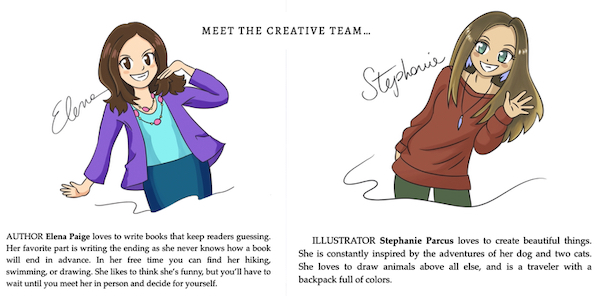
Tips for Writers Hiring Illustrators for Children’s Books
Another tip is to get a proper contract drawn up by a registered lawyer, and get it signed giving you the copyright to all the illustrations.
My first books were illustrated by someone that vanished off the planet, and every night I lie in bed and worry that they will turn up one day and demand their illustrations copyright back. We have a verbal agreement, but that’s not legally binding.
It’s also really important to find an illustrator that can draw your characters consistently. Can they draw your character from different angles, in different situations and you can recognize that character?
One time I hired an illustrator who seemed great at first, but then she kept drawing my main character, and it didn’t look like them to me at all.
Once you’ve found a terrific illustrator with a consistent style and great communication, then leave them alone to do their thing. Give them the creative control to take your idea and make it even better visually.
Advantages to Writing a Children’s Book Series
If you’re independently published, having a series can make the difference between sales and no sales.
People are more likely to buy and read a series than they are a stand-alone book. Having said that there there are authors I know who have one book and have done well, but they haven’t only got one book—they have other books for the same target audience, just not in a series.
When you have a series, you only need to promote book one and then you get read through to the rest in the series. Not all readers carry on, but many do. So when you’re paying for advertising, read through is where the real bonus lies.
Another advantage is that once you make up a world and characters, you can write about them for a long time to come. You don’t have to do all that ground work again.
This can be a huge advantage to writers who don’t like the stress of thinking up completely novel characters and novel worlds. Also readers who love your characters will often remain loyal fans over many years. Just look at the Harry Potter series, where kids grew up alongside Harry.
Disadvantages of Writing a Children’s Book Series
The one disadvantage with writing series is that it takes time, and sometimes you run out of steam in writing a series.
I started The Magicians’ Convention as a series, but then wrote something else and have never come back to it. I just didn’t have it in me to continue that series. I might come back to it one day, but all those kids that wrote to me wanting the sequel are still waiting and I feel awful about that.
So when you decide to write a series, you’re committing to hanging out in this world and with those characters for years, and you need to be aware of that commitment. I’ve been working on Evie Everyday Witch now for four years, and just finished it. That’s a long time and a long commitment.
Meanwhile my other series, called the Faren Chronicles, only has one book completed, and now I need to get back to that series to finish it. So beware jumping around as an author as I have. If I could go back I would tell myself to start one series and finish it, before starting another.
My 3 Most Effective Marketing Techniques for Children’s Books
1. The number one most effective technique for me is making book one in my series free.
This is super effective as it introduces people to my series and creates read through to my other books. If you don’t have a series, then have your book in Kindle Unlimited. You get 5 days per 3 months where you can make your book free. When you do, use a free book marketing service to get as many downloads as you can. This increases readership to your other books.
2. Putting my ebooks into Kindle Unlimited has made a huge difference to me.
I have experimented with having my books wide across all the many channels they can be sold, but most of my readers love Amazon. When you have your ebooks in Kindle Select, readers can subscribe, and read all your books for “free” as part of the subscription. And you the author gets paid by page reads. I make a lot of my income this way.
I imagine parents buy their kids a Kindle reader, a subscription, and tell their kids they can only read what is included in Kindle Unlimited. It makes sense to me, and this way as an author I am also reaching my young reader directly. Compared to parents having to look on Apple for example and buy an ebook for their children, which is much rarer. Also, having my book in Kindle Unlimited also sells more paperbacks for some reason.
3. The third best marketing technique is having a newsletter and inviting people to join my list when they finish a book.
I can then contact readers/parents/grandparents/librarians directly and let them know when a new book is being released. It’s one of the best ways to get pre-order sales, and lots of support in other ways.
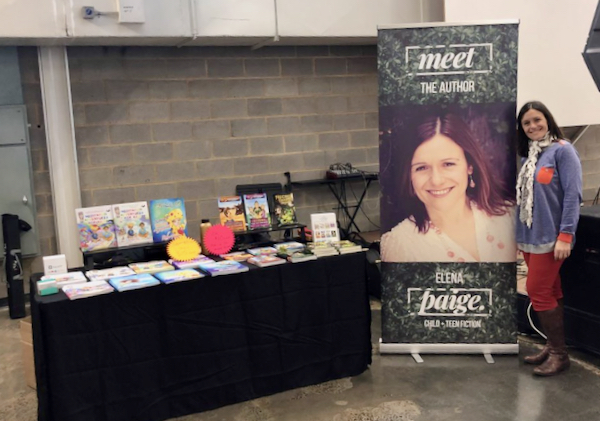
How Marketing to Young Readers is Different from Marketing to Adult Readers
When you’re marketing to young readers, you’re mostly marketing to parents, teachers and librarians.
They are the gatekeepers, because kids don’t have credit cards to make purchases with. Unlike adult readers who might see and purchase your book, you need to convince these people to buy your book for their kids.
Why I Started a Podcast and What I’ve Learned
I started the podcast as The Creative Genius At Play podcast as I wanted to be a better creative!
But after recording fifteen episodes, my energy waned and I wasn’t so motivated to continue. After leaving it for many months, I realized my true passion is all things children’s books. Even the podcasts I recorded on creativity made me a better children’s book author.
So I re-branded it to The Children’s Book Author Podcast, and it feels so right now. I can’t wait to interview other authors and experts to help children’s book authors get it right from the start rather than make all the mistakes I made over the last 6 years.
What I’ve learned about podcasting is that it’s important to make it about the audience and about informing them. Also I find it really important to be myself, to be conversational and honest and to truly connect to the person I am interviewing.
It can be a really deep connection and I come away with lots of new knowledge and insight.
Advice for Other Authors Thinking About Writing Children’s Books
First of all, read the genre you want to write.
If it’s middle-grade, read books for 8-12 year olds. If it’s picture books, read them. Lots of them. Identify the books you love, and look closely at their structure.
Yes you can do courses, lots of different courses, but there is nothing like breaking down the structure of a book you adore and studying how it was written. How the story structure is made. This is the single best way in my opinion to learn about writing great books.
Next, pay attention to their word usage.
What rhetorical devices do they use like onomotapia and similes? These all help make a book memorable and fun to read.
My other advice is to decide how you’re going to publish from really early on.
Books written for publishers, and books written for a direct audience can be very different to each other. It will definitely influence how and what you write. So the earlier you decide this the better.
Finally I would say keep at it, use editors or feedback services to get better at the craft of writing, and be very good at taking criticism and improving little by little. It does take time to become a good writer. It takes even longer to become a great writer. Invest the time in yourself and your craft.
* * *
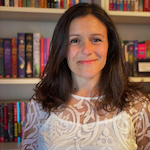 Elena Paige is a middle-grade author with a background in counseling psychology. She loves creating stories which inspire and transform young readers—either through empowering them, entertaining them, or encouraging them to be more creative and imaginative.
Elena Paige is a middle-grade author with a background in counseling psychology. She loves creating stories which inspire and transform young readers—either through empowering them, entertaining them, or encouraging them to be more creative and imaginative.
Her books, while being filled with magic and wonder, have real life characters with real life issues—like fitting in, trusting yourself, dealing with inner conflict and more!
Her greatest value in life is CREATIVITY—nurturing it, enhancing it and using it! She loves encouraging children to believe in themselves and accept their own way of creating, even if it’s outside the box. The most amazing creatives of our time rarely fitted in!
Her absolute favorite book as a child was No Flying in the House. She always knew magic was real, but when all attempts to bring her favorite teddy to life failed, she adopted a dog instead. Her Moodle dog, named Lucky, is always by her side when she writes.
On Sunday mornings you can find her hiding under her bed covers reading, while her children are wondering where their favorite book has disappeared.
For more on Elena and her work, please see her website and connect with her on Facebook, Pinterest, Instagram, and LinkedIn.
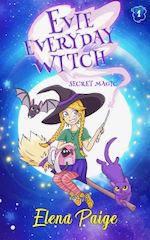 Evie Everyday Witch: My name is Evie Everyday and I’m a witch. But all I’ve ever wanted is to be normal. So when I get the chance to go to a regular school and be a regular girl I’ll do anything to fit in. Anything!
Evie Everyday Witch: My name is Evie Everyday and I’m a witch. But all I’ve ever wanted is to be normal. So when I get the chance to go to a regular school and be a regular girl I’ll do anything to fit in. Anything!
Fitting in is easy. All I have to do is:
- Keep my magic a secret
- Swap my favorite colorful clothes for boring black ones
- Suck up to scary Mrs. Rogers, the school principal
- Keep my pet cat, bat and corncob from causing any trouble
And stay away from Izzy. She’s all colorful and funny and awesome…. and not helpful for fitting in.
But when everything starts to go wrong, there’s only one way to save my new school… use magic. And only one person who can help me… Izzy!
Evie Everyday Witch is a series of chapter books that kids and parents will love. Ideal for reluctant readers. Evie’s quirky, funny personality will sweep kids off their feet, and get them reading again!
Available at Amazon.
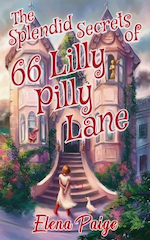 The Splendid Secrets of 66 Lilly Pilly Lane: Twelve-year-old Chia is blind and toils in the mines digging up diamonds for her evil stepmother, Priscilla. Her only thought is to rescue her twin sister Viola from a life at the palace.
The Splendid Secrets of 66 Lilly Pilly Lane: Twelve-year-old Chia is blind and toils in the mines digging up diamonds for her evil stepmother, Priscilla. Her only thought is to rescue her twin sister Viola from a life at the palace.
Everything changes when a mysterious woman transports Chia to 66 Lilly Pilly Lane, a magical house where wondrous creatures live. To her delight, she’s no longer blind! With an entourage at her side and magic at her fingertips, it’s time to rescue Viola from Priscilla’s clutches and start a new life elsewhere.
The trouble is, her new friends claim Viola is not as innocent and helpless as she seems…
Come on a magical adventure to discover The Splendid Secrets of 66 Lilly Pilly Lane, a middle-grade novel that will entertain and delight even the most reluctant of readers.
Ideal for kids ages 9+ and adults who love adventurous, page-turning fantasy stories.
Available at Amazon.

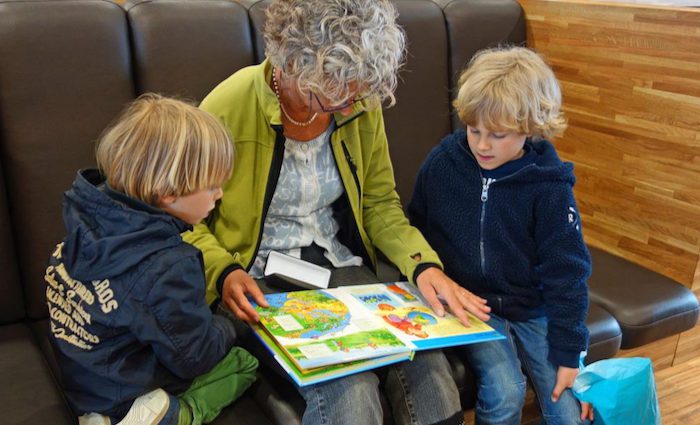
Thanks for sharing this post about writing children’s books Colleen. Looking forward to seeing you at the Idaho Writers Conference next May in Boise. https://idahowritersguild.org/2023-idaho-writers-guild-conference/
Thanks, Pam! And thanks to Elena for her tips. I’m definitely looking forward to the conference! :O)